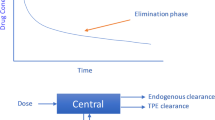Abstract
Purpose. This study was conducted to assess the effects of anesthesia and aqueous humor protein concentrations on ocular disposition of propranolol.
Methods. Rabbits were anesthetized and a microdialysis probe was inserted into the anterior chamber of one eye; the contralateral eye served as a control. At timed intervals after probe placement, a 100-μl sample of aqueous humor was aspirated from each eye to determine protein concentration. In vitro protein binding parameters were used to simulate the impact of protein concentration on propranolol disposition. To assess the influence of anesthesia, probes were implanted in the anterior chamber of each eye. After >5-day stabilization, conscious and anesthetized rabbits (n = 3/group) received a 200-μg topical dose of [3H] DL-propranolol in each eye; propranolol was assayed in probe effluent.
Results. Changes in aqueous humor protein concentrations were observed following probe insertion. Simulations demonstrated that the unbound propranolol AUC (∼2.4-fold) in aqueous humor should be reduced due to protein influx. Intraocular propranolol exposure in anesthetized rabbits was ∼8-fold higher than in conscious rabbits, and ∼1.9-fold higher than in rabbits without a post-surgical recovery period.
Conclusions. Anesthesia and time-dependent aqueous humor protein concentrations may alter ocular pharmacokinetics, and must be taken into account in the design of microdialysis experiments.
Similar content being viewed by others
REFERENCES
J. Waga, A. Ohta, and B. Ehinger. Intraocular microdialysis with permanently implanted probes in rabbit. ACTA Ophthalmologica. 69:618-624 (1991).
J. Ben-Nun, D. A. Joyce, R. L. Cooper, and S. J. Cringle. Pharmacokinetics of intravitreal injection. Invest. Ophthalmol. Vis. Sci. 30:1055-1061 (1989).
N. Stempels, M-J. Tassignon, and S. Sarre. A removable ocular microdialysis system for measuring vitreous biogenic amines. Graefe's Arch. Clin. Exp. Ophthalmol. 231:651-655 (1993).
P. Louzada-Junior, J. J. Dias, W. F. Santos, J. J. Lachat, H. F. Bradford, and J. Coutinho-Netto. Glutamate release in experimental ischaemia of the retina: an approach using microdialysis. J. Neurochem. 59:358-363 (1992).
G. Tsai, G. Forloni, M. B. Robinson, B. L. Stauch, and J. T. Coyle. Calcium-dependent evoked release of N-[3H]Acetylaspartylglutamate from the optic pathway. J. Neurochem. 51:1956-1959 (1998).
H. Sato, S. Fukuda, M. Inatomi, R. Koide, N. Uchida, Y. Kanda, Y. Kiuchi, and K. Oguchi. Pharmacokinetics of norfloxacin and lomefloxacin in domestic rabbit aqueous humor analyzed by microdialysis. J. Jpn. Ophthalmol. 7:513-519 (1995).
K. D. Rittenhouse, R. L. Peiffer Jr., and G. M. Pollack. Evaluation of microdialysis sampling of aqueous humor for in vivo models of ocular absorption and disposition. J. Pharm. Biomed. Anal. 16:951-959 (1998).
R. Ohtori, H. Sato, S. Fukuda, T. Ueda, R. Koide, Y. Kanda, Y. Kiuchi, and K. Oguchi. Pharmacokinetics of topical beta-adrenergic antagonists in rabbit aqueous humor evaluated with the microdialysis method. Exp. Eye. Res. 66:487-494 (1998).
E. Noack. Treatment of glaucoma with beta-receptor blockers. Significance of adrenergic receptors of the beta-2 subtype for their effect on intraocular pressure. Ophthalmologica. 196:76-81 (1988).
F. E. Ross, H. C. Innemee, and P. A. Van Zwieten. Ocular penetration of β-adrenergic blocking agents. An experimental study with atenolol, metoprolol, timolol and propranolol. Documenta Ophthalmoligica. 48:291-301 (1979).
D. F. Cole. Secretion of the aqueous humor. Exp. Eye Res. 25(suppl.):161-176 (1977).
P. S. Kulkarni and B. D. Srinvasan. Nonsteroidal anti-inflammatory drugs in ocular inflammatory conditions in: A. J. Lewis, D. E. Furst eds., Nonsteroidal Anti-Inflammatory Drugs. Marcel Dekker, New York, 1987.
M. Rowland and T. N. Tozer. Clinical Pharmacokinetics: Concepts and Applications. 3rd ed. Media, PA: Williams and Wilkins, 1995.
L. L. Stale in: Robinson LE, Justice JB Jr., eds. Microdialysis in the Neurosciences. Amsterdam: Elsevier, 1991.
O. H. Lowry, J. J. Rosebrough, A. L. Farr, and R. J. Randall. Protein measurement with Folin phenol reagent. J. Biol. Chem. 193:265-275 (1951).
J. D. Wright, F. D. Boudinot, and M. R. Ujhelyi. Measurement and analysis of unbound drug concentrations. Clin Pharmacokinet. 30:445-462 (1996).
M. Gibaldi and D. Perrier. Pharmacokinetics, 2nd ed. New York: Marcel Dekker, 1982.
A. M. Herrera, D. O. Scott, and C. E. Lunte. Microdialysis sampling for determination of plasma protein binding of drugs. Pharm. Res. 7:1077-1081 (1990).
S. Glasson, R. Zini, P. D'Athis, J. P. Tillement, and J. R. Boissier. The distribution of bound propranolol between different human serum proteins. Mol. Pharmacol. 17:187-191 (1980).
Masuda K, Izawa Y, and Mishima S. Breakdown of the blood:aqueous barrier and prostaglandins. Bibliotheca Anatomica. 16:99-104 (1977).
E. Latoure, J. Y. Driot, C. Coquelet, and C. Bonne. The role of platelets in blood-aqueous barrier breakdown induced by anterior paracentesis in the rabbit. Curr. Eye Res. 8:1105-1110 (1989).
M. M. Tahery and D. A. Lee. Review: pharmacologic control of would healing in glaucoma filtration surgery. J. Ocul. Pharmacol. 5:155 (1989).
C. Schmitt, V. J. Lotti, and J. C. LeDovarec. Penetration of five beta-adrenergic antagonists into the rabbit eye after ocular instillation. Albrecht von Graefes Arch. Klin. Ophthalmol. 217:167-174 (1981).
A. Hussain, S. Hirai, and J. Sieg. Ocular absorption of propranolol in rabbits. J. Pharm. Sci. 69:738-739 (1980).
J. W. Sieg and J. R. Robinson. Vehicle effect on ocular drug bioavailability I: evaluation of fluorometholone. J. Pharm. Sci. 64:931-936 (1980).
S. S. Chrai, T. F. Patton, A. Mehta, and J. R. Robinson. Lacrimal and instilled fluid dynamics in rabbit eyes. J. Pharm. Sci. 62:1112-1121 (1973).
Author information
Authors and Affiliations
Corresponding author
Rights and permissions
About this article
Cite this article
Rittenhouse, K.D., Peiffer, R.L. & Pollack, G.M. Microdialysis Evaluation of the Ocular Pharmacokinetics of Propranolol in the Conscious Rabbit. Pharm Res 16, 736–742 (1999). https://doi.org/10.1023/A:1018884826943
Issue Date:
DOI: https://doi.org/10.1023/A:1018884826943




